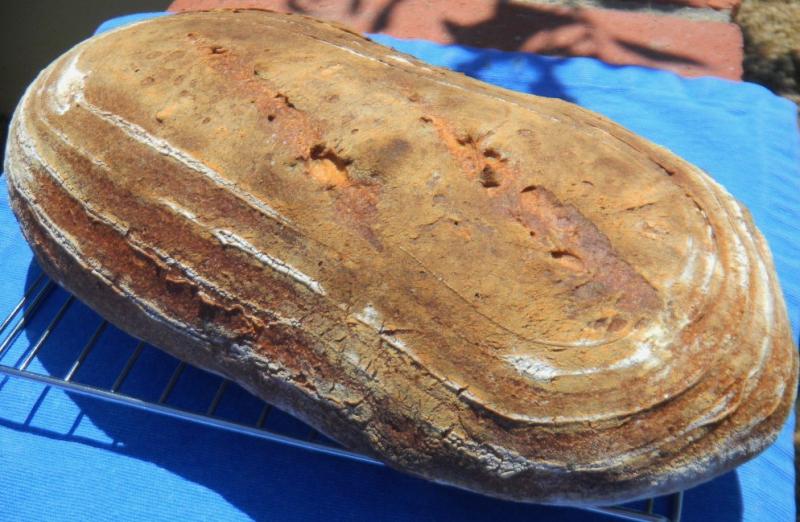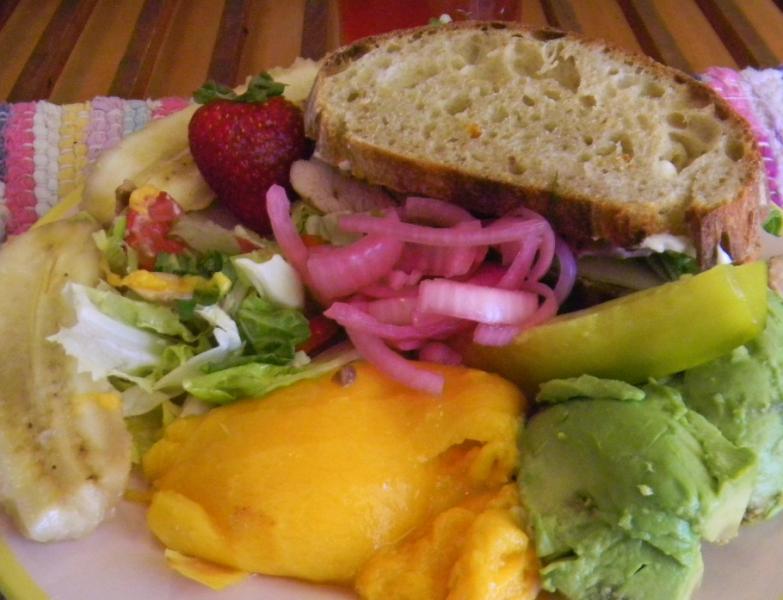Found some Canadian durum attta in the Indian aisle at the Lee Lee’s Chinese grocery- real globalization at work. The brand was Golden Temple. The ‘atta’ makes this flour different than regular durum or semolina since it still has the bran in it.




We love the way the yellow durum flour softly colors the inside of white breads and gives the outside a rich brown hue. This was more of a basic white bread with just a hint of rye and WW in the starter, levain build and dough at a total of 10%. The durum makes up 47% of this bread with AP flour comes in at 43%. The hydration was 73%.


For some reason, probably because I froze it the week before, the 33% each AP, rye and WW starter that we keep 80 grams of in the fridge, was weaker than normal so it was slow to build strength over the normal 12 hour, 3 stage, levain build. Usually it is ready to go in 8 hours in the summer heat but it took a full 12 hours to double this time. Maybe it didn’t like the white flour diet it hardly ever sees too.


Preheating and Sylvia’s steaming method went well but the dough stuck to the wooden articulating form and deflated as it released but it sprang back very nicely in the oven like a ciabatta. I’m guessing poor forming and slashing caused the batard to split along the length of both of the long sides of the bottom - so the bloom at the slashes was pretty weak.


The crust browned nicely and came out of the oven slightly blistered and cracked. The crust was very crispy when it came out of the heat and then softened as it cooled like a ciabatta.


The crumb was a pale yellow shade due to the durum and it had some nice holes, was airy, soft and moist.
This is tangy SD bread that tastes good. It will make some kind of fine sandwich for lunch. Method and formula follow the pictures.
Method
This was a 2 day build where the levain was built and the flours autolysed with the salt in the fridge for 10 hours waiting for the 12 hour levain build to finish . At the 10 hour mark the autolyse was removed from the fridge so it could come to room temperature over the next 2 hours.
When the levain was ready it was mixed with the autolyse by hand with a spoon, kneaded on a floured surface for 1 minute. The dough was then placed in a covered oiled bowl to rest for 15 minutes.
5 S&F’s were done on an oiled work surface every 15 minutes and the dough allowed to rest in the covered oiled bowl between each one. The dough was then allowed to ferment and develop for 1 ½ hours on the counter before being refrigerated overnight.
The dough was removed from the fridge in the morning and allowed to come to room temperature for 1 ½ hours. It was then pre-shaped into a batard and allowed to rest for 10 minutes before final shaping. The batard was placed into a rice floured wooden contraption and allowed to double in a plastic trash sack until it passed the poke test – about 3 hours – about an hour longer than normal due to the levain not being as active as normal.
The batard was removed from the wooden contraption by folding it flat and upturning the batard on to parchment and a peel. We liked the Egyptian stepped mastaba shape (it almost nearly left) on the bread so much, we will call this forming articulating appliance the ‘Pharaoh’s Mastaba.’
Sylvia’s steaming method was used in the 500 F mini oven using a 1 cup Pyrex measure, half full of water, with a face towel. This apparatus was micro waved for 1 ½ minutes to get the water boiling before putting it onto the cold broiler top as batard was load on it and placed with the steaming cup into the oven.
4 minutes into the bake the temperature was turned down to 450 F and steaming continued to the 12 minute mark when the steam and parchment was removed and the temperature tuned down to 400 F convection this time. The batard was rotated 180 degrees ever 5 minutes until the batard was done, 205 F inside temperature – about 20 more minutes – 32 minutes total.
The batard was left in the mini oven for 10 minutes with the oven turned off and door ajar to further crisp the skin before removing it to a cooling rack.
| Sourdough Durum Atta Bread | | | | | |
| | | | | | |
| SD Levain | Build 1 | Build 2 | Build 3 | Total | % |
| SD Starter | 10 | 0 | 0 | 10 | 2.00% |
| Rye | 5 | 0 | 0 | 5 | 1.30% |
| AP | 10 | 20 | 10 | 40 | 10.39% |
| Durum Atta | 0 | 30 | 30 | 60 | 15.58% |
| WW | 5 | 0 | 0 | 5 | 1.30% |
| Water | 20 | 50 | 40 | 110 | 28.57% |
| Total Starter | 50 | 100 | 80 | 230 | 59.74% |
| | | | | | |
| Levain | | | | | |
| Hydration | 100.00% | | | | |
| Levain % of Total | 26.38% | | | | |
| | | | | | |
| Dough Flour | | % | | | |
| Durum Atta | 175 | 45.45% | | | |
| AP | 175 | 45.45% | | | |
| Oats | 15 | 3.90% | | | |
| Rye | 5 | 1.30% | | | |
| WW | 5 | 1.30% | | | |
| Potato Flakes | 10 | 2.60% | | | |
| Dough Flour | 385 | 100.00% | | | |
| Salt | 7 | 1.82% | | | |
| water | 250 | 64.94% | | | |
| Dough Hydration | 64.94% | | | | |
| | | | | | |
| Total Flour | 500 | | | | |
| Total Water | 365 | | | | |
| T. Dough Hydration | 73.00% | | | | |
| Whole Grain % | 4.00% | | | | |
| | | | | | |
| Hydration w/ Adds | 73.00% | | | | |
| Total Unbaked Weight | 872 | | | | |
| Baked Weight | 773 | 88.65% | | | |





